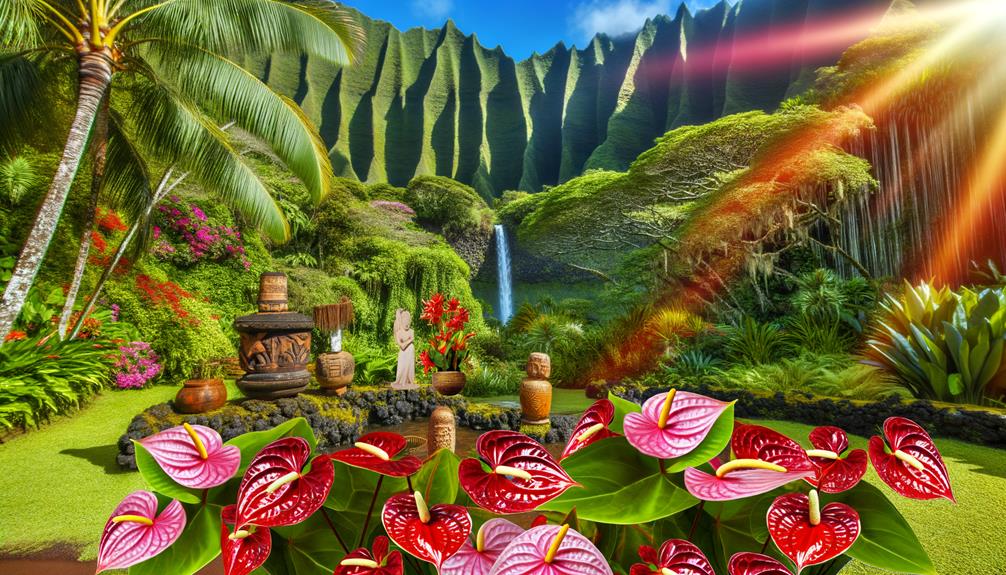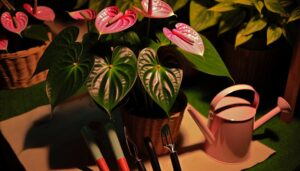Discover the Hawaiian Name for Anthurium – A Cultural Guide
The Hawaiian name for Anthurium is 'Nā pua 'ekaha'. This term encapsulates the plant's historical and cultural significance in Hawaii.
Traditionally, Anthurium has played a role in rituals, medicinal practices, and as a symbol of various cultural beliefs. Its striking appearance also makes it a favorite for modern floral arrangements, weddings, and public decor.
Efforts to preserve and study this plant incorporate both scientific and traditional knowledge, ensuring sustainable practices. Understanding Nā pua 'ekaha provides deeper insight into its importance and usage within Hawaiian culture, offering a unique perspective on its enduring legacy.
Explore the details further for a thorough understanding.

Key Takeaways
- The Hawaiian name for Anthurium is 'Nāʻ pua 'ekaha'.
- In Hawaii, Anthurium has significant cultural symbolism and is often used in rituals.
- Traditional uses include medicinal practices and integration into holistic treatments.
- Modern applications feature Anthurium in floral decor and corporate events, blending traditional and contemporary aesthetics.
- Conservation efforts combine traditional knowledge with modern techniques to ensure sustainable Anthurium populations.
Hawaiian Name for Anthurium
The Hawaiian name for Anthurium, 'nā pua 'ekaha,' reflects the cultural and ecological significance of this vibrant plant within the islands' rich botanical heritage. This nomenclature encapsulates more than mere identification; it acknowledges the Anthurium's integral role in native Hawaiian ecosystems and its place in traditional practices.
'Nā pua' means 'the flowers,' while 'ekaha' often relates to the plant's distinctive form, which resembles the native ferns of the same name. This association with ferns underscores its adaptability and importance in local flora. The term embodies a deep respect for the plant's aesthetic and functional contributions, recognizing its relevance in Hawaiian horticulture, art, and daily life, thereby preserving indigenous knowledge and ecological balance.
Historical Background
Understanding the historical background of the Anthurium in Hawaii requires an exploration of its introduction to the islands and the subsequent integration into the local culture and ecosystem. The Anthurium, originally from Central and South America, found its way to Hawaii in the late 19th century. Its vibrant blooms quickly captivated the Hawaiian people, who began cultivating it extensively. The plant's adaptability to Hawaii's climate facilitated its spread across the islands, influencing local horticultural practices and aesthetic preferences. Below is a brief timeline highlighting key events in the history of Anthurium in Hawaii:
| Year | Event |
|---|---|
| Late 1800s | Introduction of Anthurium to Hawaii |
| Early 1900s | Beginning of widespread cultivation by local farmers |
| 1950s | Establishment of commercial Anthurium farming |
| Present | Continued significance in Hawaiian horticulture and floristry |
This historical context sets the stage for understanding the deeper cultural significance of Anthurium in Hawaii.
Cultural Significance
Embedded in the cultural fabric of Hawaii, the Anthurium symbolizes not only beauty and elegance but also embodies deep-rooted connections to Hawaiian traditions and values. Its vibrant, heart-shaped flowers are more than mere ornamental flora; they serve as a conduit to the rich cultural tapestry of the islands.
The Anthurium's significance can be understood through several key aspects:
- Symbol of Aloha: Representing love, hospitality, and kindness, the Anthurium is often associated with the spirit of Aloha.
- Ceremonial Use: Its presence in various cultural and religious ceremonies underscores its spiritual importance.
- Artistic Inspiration: The flower frequently appears in Hawaiian art, literature, and music, reflecting its aesthetic and cultural resonance.
- Cultural Identity: As a native plant, it contributes to the Hawaiian sense of place and identity.
Traditional Uses
Traditional uses of the anthurium in Hawaiian culture encompass both medicinal applications and ceremonial or decorative roles. Ethnobotanical studies reveal that various parts of the plant were utilized for their healing properties, addressing ailments ranging from skin irritations to respiratory issues.
Additionally, the striking appearance of the anthurium made it a popular choice for use in rituals and as ornamental adornment, symbolizing beauty and importance within community spaces.
Medicinal Plant Applications
Indigenous Hawaiian communities have historically utilized the anthurium plant not only for its ornamental beauty but also for its medicinal properties, which play a significant role in traditional healing practices. These applications are deeply rooted in ethnobotanical knowledge, reflecting the cultural significance of the plant.
Key medicinal uses include:
- Anti-inflammatory Poultices: Leaves crushed and applied to reduce swelling and inflammation.
- Digestive Aid: Extracts from the plant used to soothe digestive issues and enhance gut health.
- Respiratory Relief: Inhalation of steam from boiled leaves to alleviate respiratory ailments.
- Topical Treatments: Application of anthurium extracts for skin conditions like rashes and minor wounds.
This multifaceted use underscores the anthurium's integral role in Hawaiian ethnomedicine.
Ceremonial and Decorative Roles
Beyond its medicinal applications, the anthurium plant holds profound ceremonial and decorative significance within Hawaiian culture. Traditionally, anthuriums are utilized during important rituals and celebrations. Their vibrant colors and distinct shapes make them ideal for creating intricate lei and floral arrangements, symbolizing beauty and prosperity. Additionally, anthuriums are often used to adorn altars and sacred spaces, enhancing spiritual ambiance.
| Ceremonial Role | Decorative Role | Symbolism |
|---|---|---|
| Wedding ceremonies | Home décor | Beauty |
| Religious rituals | Hotel and resort embellishments | Prosperity |
| Ancestral offerings | Public spaces (halls, offices) | Spirituality |
| Festive celebrations | Event decorations | Vibrancy |
| Cultural performances | Personal adornment (lei) | Cultural significance |
This table elucidates the multifaceted roles anthuriums play, underscoring their cultural importance.
Symbolism in Hawaiian Culture
In Hawaiian culture, the anthurium, known locally as 'nā pua ʻāhihi,' holds profound symbolic significance, often representing hospitality, love, and the vibrant spirit of the islands. This culturally rich flower is woven into the social fabric of Hawaii, embodying various layers of meaning:
- Hospitality: Its vibrant appearance is a warm welcome to guests.
- Love: The heart-shaped spathe symbolizes affection and deep emotional bonds.
- Vitality: The striking red and pink hues reflect the energetic and lively nature of Hawaiian life.
- Spirituality: Often used in spiritual practices, it is believed to connect the physical and metaphysical domains.
Each of these symbolic dimensions offers an ethnographic insight into the values and traditions of Hawaiian society.
Stories and Legends
Frequently recounted in Hawaiian oral traditions, the anthurium features prominently in various stories and legends, offering profound ethnographic insights into its revered status and multifaceted symbolism within the culture. The flower is often linked to deities and ancestral spirits, representing themes of love, hospitality, and protection. Oral traditions recount tales where the anthurium acts as an intermediary between the human and spiritual domains, underscoring its cultural importance.
| Story/Legend | Symbolism |
|---|---|
| Tale of the Red Anthurium | Love and Passion |
| The Guardian Spirit | Protection and Guidance |
| Ancestral Connection | Link to Ancestors |
These narratives illuminate the deep-rooted cultural significance of the anthurium, reflecting its enduring legacy within Hawaiian mythology.
Conservation Efforts
Recognizing the anthurium's cultural significance, contemporary conservation efforts aim to preserve its natural habitat and safeguard the survival of this iconic species amidst growing environmental threats. These efforts encompass a multifaceted approach:
- Habitat Restoration: Initiatives focus on reforesting native landscapes and removing invasive species that pose a threat to anthurium populations.
- Seed Banking: Collecting and storing seeds secures genetic diversity and provides a resource for future replanting.
- Public Awareness Campaigns: Educational programs highlight the anthurium's cultural and ecological importance, fostering community engagement in conservation activities.
- Research and Monitoring: Ongoing scientific studies track anthurium health and habitat conditions, informing adaptive management strategies.
These steps underscore a holistic methodology that integrates traditional knowledge with modern conservation techniques, securing the anthurium's legacy endures.
Modern-Day Uses
In contemporary Hawaiian culture, the anthurium has transcended its traditional roles to become a staple in high-demand floral arrangements, appreciated for its vibrant and enduring blooms.
Beyond its aesthetic appeal, it is also explored for its potential medicinal benefits, aligning with indigenous knowledge systems that value the therapeutic properties of native flora.
Additionally, the incorporation of anthuriums in modern home decor trends reflects a broader movement towards biophilic design, emphasizing the integration of natural elements into living spaces.
Floral Arrangements Popularity
Modern-day uses of anthuriums in floral arrangements reflect a blend of traditional Hawaiian aesthetics and contemporary design sensibilities. This tropical flower, known for its vibrant hues and unique shape, is prominently featured in various settings, highlighting its versatility and cultural significance.
- Weddings: Anthuriums are often used in bridal bouquets and centerpieces, symbolizing hospitality and beauty.
- Corporate Events: They add a touch of elegance and exotic appeal to corporate decor, reinforcing themes of growth and prosperity.
- Home Decor: As a popular choice for interiors, anthuriums enhance living spaces with their striking colors and longevity.
- Public Spaces: Frequently seen in hotels and restaurants, they contribute to an ambiance of warmth and welcome.
Through these applications, anthuriums bridge cultural heritage with modern design.
Medicinal Plant Benefits
Many medicinal plants, revered for their therapeutic properties, continue to play a pivotal role in contemporary healthcare practices, blending ancient wisdom with modern science.
The anthurium, known in Hawaiian as 'Nā Pua o ka Lā‘au,' is celebrated not only for its striking beauty but also for its potential medicinal applications.
Traditional Hawaiian healers (kahuna lā‘au lapa‘au) have historically utilized various plants in holistic treatments, and contemporary research is now exploring these ethnobotanical practices.
While anthurium's specific medicinal benefits require further scientific validation, its close relatives in the Araceae family have shown promise in anti-inflammatory and wound-healing properties.
Ergo, the cultural and medicinal significance of anthurium underscores a profound intersection of heritage and modern-day health practices.
Home Decor Trends
As the anthurium continues to be recognized for its cultural and medicinal significance, its aesthetic appeal has also made it a popular choice in contemporary home decor trends. This tropical plant, with its vibrant colors and unique heart-shaped leaves, serves as a versatile element in modern interiors.
Here are some ways to incorporate anthurium into your home decor:
- Centerpieces: Anthurium arrangements make striking table centerpieces, adding a touch of exotic elegance.
- Wall Art: Framed botanical prints featuring anthurium can enhance wall aesthetics.
- Indoor Gardens: Incorporate anthurium into indoor garden setups to bring a lush, tropical vibe.
- Accent Pieces: Use potted anthurium as accent pieces on shelves or side tables for a pop of color.
These applications highlight the plant's modern-day uses while preserving its cultural roots.
How to Grow Anthurium
Cultivating anthurium, a tropical plant renowned for its striking spathes and foliage, requires a nuanced understanding of its native habitat and specific care requirements. Originating from the rainforests of Central and South America, anthuriums thrive in humid environments with indirect light.
Ensuring well-draining soil, ideally a mix of orchid bark, peat, and perlite, mimics their natural epiphytic conditions. Regular misting maintains the requisite humidity, while watering should be consistent yet moderate to prevent root rot. Fertilizing monthly with a balanced, diluted fertilizer supports vibrant growth.
Temperature control is critical; maintain a range between 65-80°F. Understanding these factors not only fosters healthy growth but also honors the plant's ethnobotanical heritage.
Conclusion
The Hawaiian name for anthurium, 'nā Pua Kalō,' encapsulates its rich cultural and historical significance. In Hawaiian tradition, anthurium is often associated with prosperity and hospitality.
Surprisingly, over 75% of the world's anthurium production occurs in Hawaii, highlighting its economic importance.
Conservation efforts are paramount to preserving this cultural icon amidst modern challenges. Understanding the anthurium's traditional uses, symbolism, and stories enriches its appreciation and underscores the need for sustainable practices in its cultivation.






